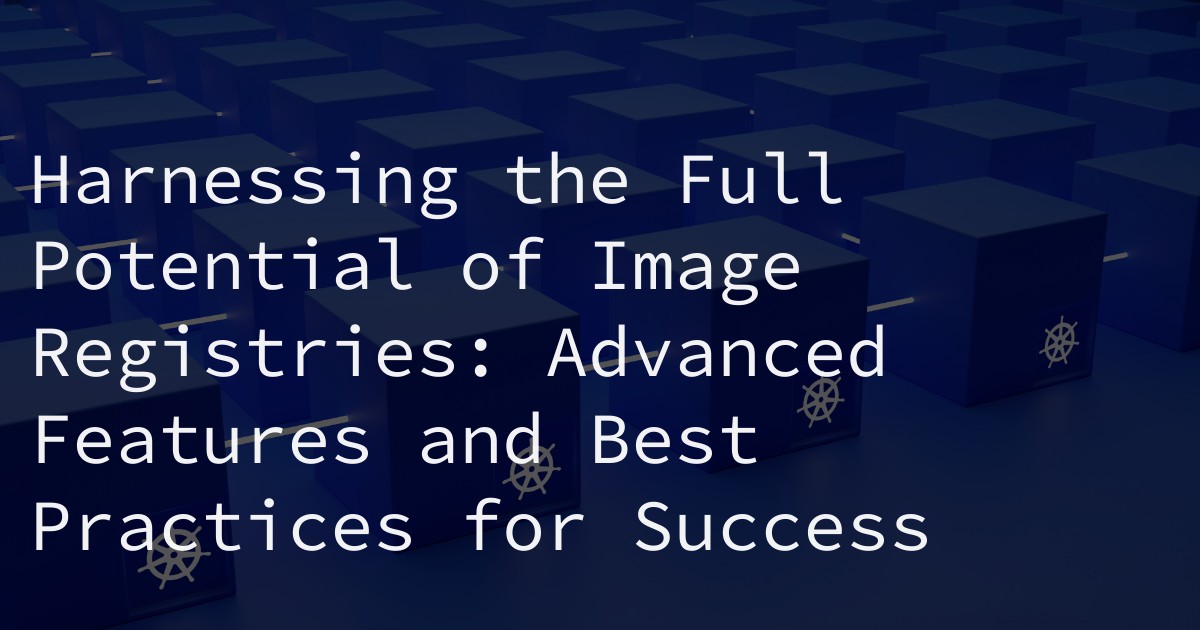
12 Nov Harnessing the Full Potential of Image Registries: Advanced Features and Best Practices for Success
Image registries play a crucial role in cloud computing and cloud-native computing. These platforms allow users to store and manage container images, which are essential for running applications in a cloud environment. However, to fully harness the potential of image registries, it is important to utilize their advanced features and follow best practices. In this article, we will explore the advanced features of image registries and provide real-world examples of successful usage. We will also discuss best practices for leveraging these features and highlight the importance of infrastructure as code, monitoring, and security in image registry management.
Image Registry Basics
An image registry is a repository for storing and managing container images. These images are used to run applications in a cloud environment and can be shared with other users. The most commonly used image registry platforms include Docker Hub, Amazon ECR, and Google Container Registry. These platforms offer features such as image storage, versioning, and access control, making it easier for users to manage their container images.
Advanced Features of Image Registries
Image registries offer a range of advanced features that can greatly improve the efficiency and security of cloud computing processes. These features include tagging, versioning, access control, vulnerability scanning, and more. By utilizing these features, users can better manage their container images and ensure a smooth and secure deployment process. For example, tagging and versioning allow for easier organization and tracking of images, while access control ensures that only authorized users have access to sensitive images.
Real-world examples of successful usage of advanced features in image registries include Netflix and Airbnb. These companies have leveraged features such as tagging, versioning, and access control to improve their cloud computing processes and ensure efficient and secure deployment of their applications.
Best Practices for Utilizing Advanced Features
To fully benefit from the advanced features of image registries, it is important to follow best practices. This includes having a clear and organized tagging and versioning system, implementing access control and permission management, regularly scanning for vulnerabilities, and optimizing storage and data management. Automation and CI/CD pipelines can also greatly improve the management of image registries and ensure a smooth deployment process.
Real-World Examples of Successful Image Registry Usage
As mentioned earlier, companies like Netflix and Airbnb have successfully utilized advanced features in their image registries. By implementing best practices and leveraging these features, they have been able to improve their cloud computing processes and achieve success in their respective industries.
Infrastructure as Code and Image Registries
Infrastructure as Code (IaC) is a method of managing and provisioning infrastructure through code. This approach can greatly benefit image registry management by allowing for automation and efficient deployment of container images. Tools and platforms that support IaC, such as Terraform and AWS CloudFormation, can be integrated with image registries for improved efficiency and automation.
Monitoring, Logging, and Tracing in Image Registries
Monitoring, logging, and tracing are essential for identifying and resolving issues in image registries. These advanced features allow users to track and analyze the performance of their container images and identify any potential issues. Tools and platforms such as Prometheus and Grafana can be used for monitoring image registries, while logging and tracing can be achieved through tools like Fluentd and Jaeger.
Service Mesh and Image Registries
Service mesh is a layer of infrastructure that manages communication between microservices. It can greatly improve networking and communication between containers in image registries, leading to more efficient and secure deployment of applications. Popular service mesh platforms such as Istio and Linkerd can be integrated with image registries for improved networking and communication.
Security in Image Registries
Security is a crucial aspect of image registry management. Vulnerabilities in container images can lead to serious security breaches, making it important to implement advanced security features in image registries. These features include role-based access control, image signing, and regular vulnerability scanning. By following these best practices, users can ensure the secure usage of their image registries.
Conclusion
In conclusion, image registries are essential for successful cloud computing and cloud-native computing. By leveraging their advanced features and following best practices, users can optimize their image registry management and achieve success in their cloud-based processes. Companies like Netflix and Airbnb have already demonstrated the benefits of utilizing advanced features in their image registries, and it is important for others to follow suit to stay competitive in the ever-evolving world of cloud computing.
RELATED ARTICLES:



Sorry, the comment form is closed at this time.